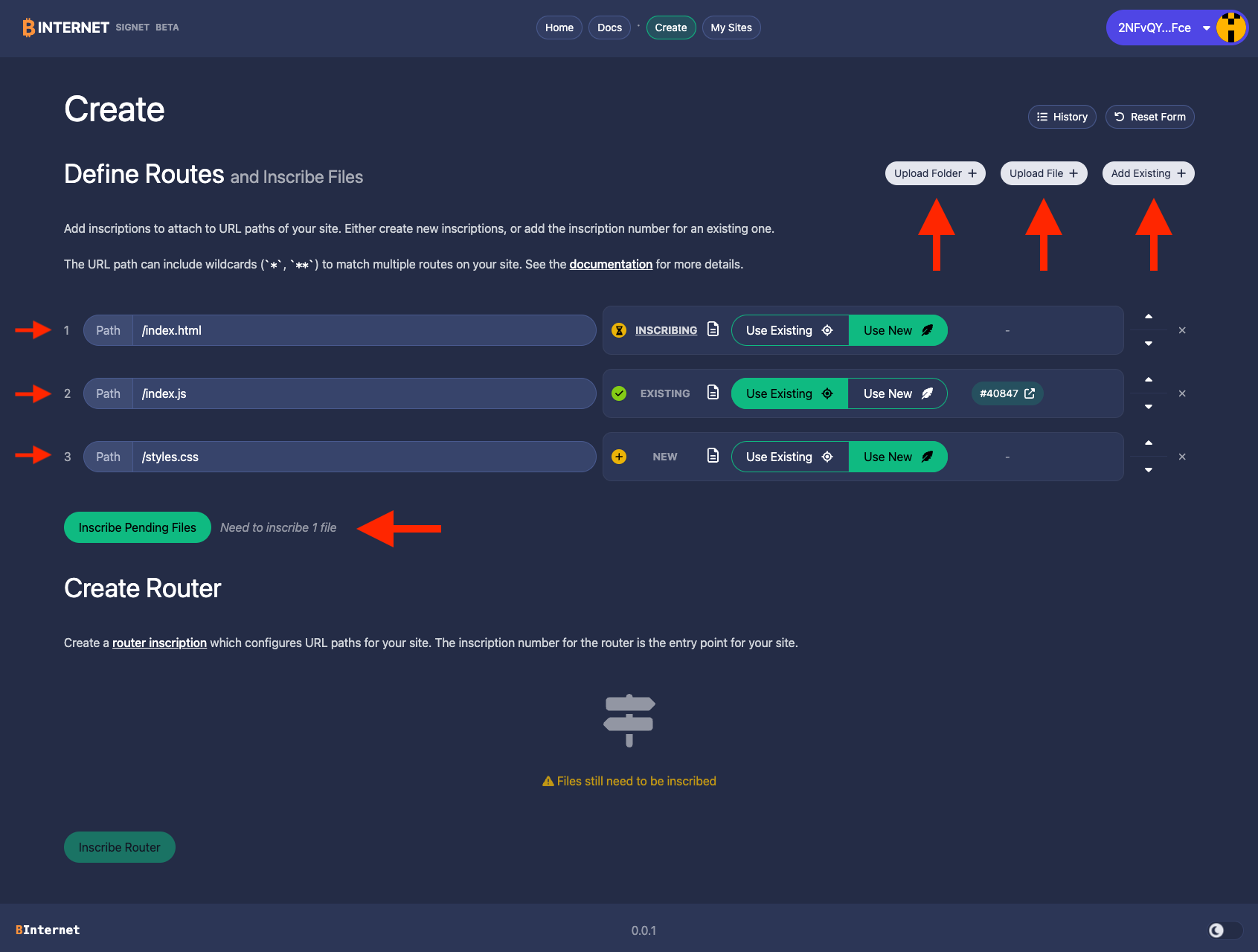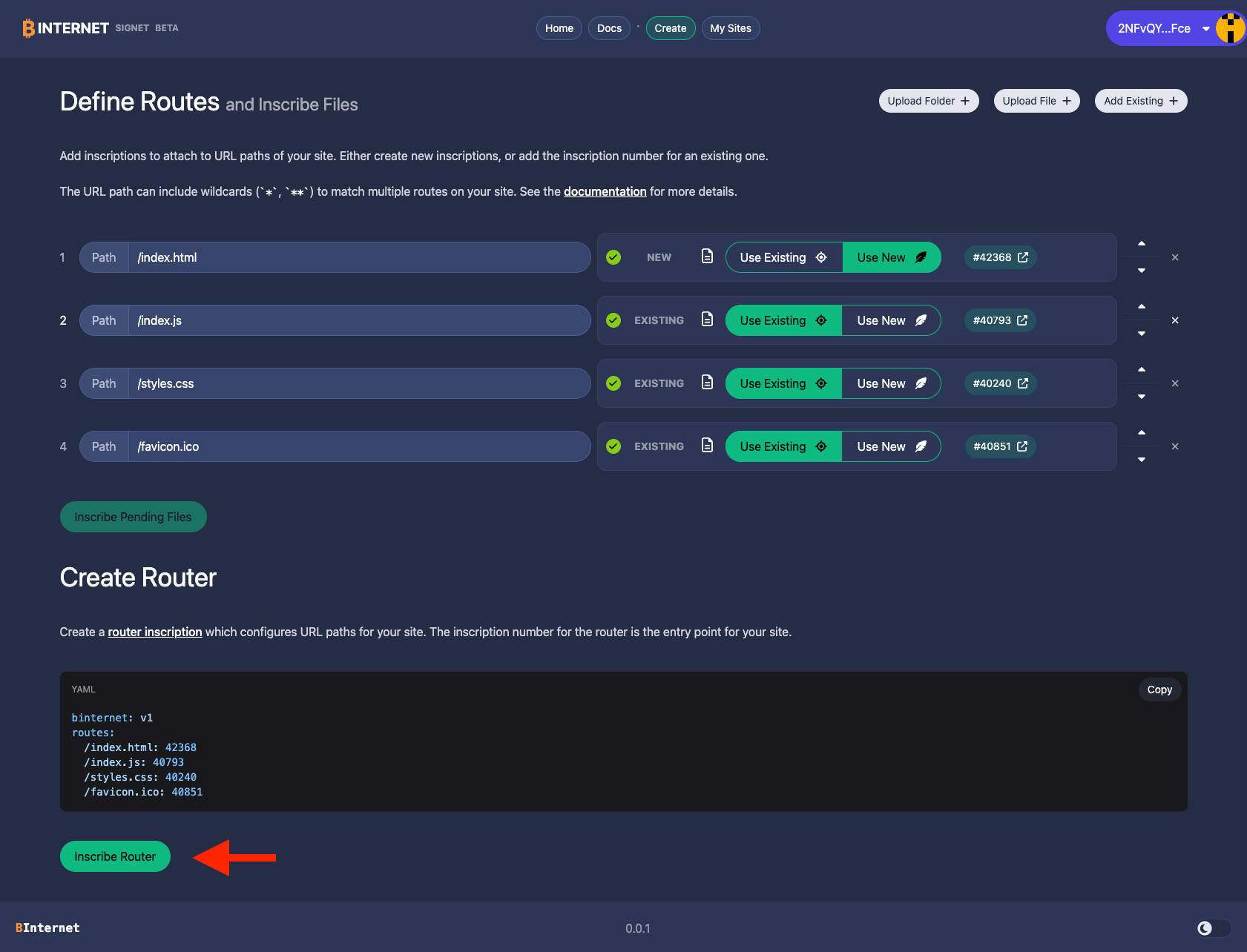Documentation
Introduction
This documentation provides an overview and step-by-step guide on how to inscribe a static website onto the Bitcoin blockchain using HTML files and router inscriptions.
Overview
You can inscribe a static website onto the Bitcoin blockchain.
This process involves inscribing HTML files and other website assets onto the chain.
Afterwards, you can create a Router Inscription to define the URL paths of your website, which reference the inscription number of your inscribed files.
Asset Inscriptions
An Asset Inscription is a file which is makes up part of your website.
e.g., HTML, CSS, JS, images, etc.
Router Inscriptions
A Router Inscription is a YAML file which maps URL paths to the inscriptions used as website assets.
e.g.,
binternet: v1
routes:
# HTML
/: 100001 # homepage.html
/runes: 100002 # runes.html
/about: 100003 # about.html
/contact: 100004 # contact.html
/app/**: 100005 # single_page_app.html
# JS/CSS
/script.js: 100006
/styles.css: 100007
# Image Assets
/runes/going_to_the_moon.gif: 100008
/runes/laser_eyes_effect.gif: 100009
/favicon.gif: 100010Each path in under routes maps to an inscription number.
The inscription data corresponding to the inscription number will be returned when the user navigates to the matching URL path.
Router Specification
A Router Inscription is the configuration which defines the routes for your website.
The inscription number for the router can be thought as similar to a (permanent) static IP address and can be used as the entry point for your site.
YAML Schema
binternet: <VERSION>
routes:
<URL_PATH>: <INSCRIPTION_NUMBER>
# ...Version
v1 is the currently available version.
Routes
URL paths use glob syntax.
*matches a single file/folder**matches zero or more folders
URL paths must start with /.
If multiple router paths match a URL, the first matching path is used.
e.g.,
binternet: v1
routes:
/foo: 100001
/foo/*: 100002
/foo/**: 100003/foomatches the/fooroute./foo/barmatches the/foo/*route./foo/bar/bazmatches/foo/**.
How to Create a Site
Manual Process
Create Inscriptions
- Inscribe data containing file data for the assets of your site (HTML, JS, CSS, images, etc.). Keep note of the inscription numbers for each asset.
- If an inscription with identical data already exists, you use the inscription number for the existing asset instead of creating a new inscription.
Example:
- Inscribe
index.html(inscription number: 100001) - Inscribe
about.html(inscription number: 100002) - Inscribe
favicon.png(inscription number: 100003) - Inscribe
frog.gif(inscription number: 100004)
Create a Router Inscription
Create a YAML file following the example schema below.
Map URL paths to corresponding inscription numbers.
Example:
binternet: v1 routes: /: 100001 /about: 100002 /favicon.png: 100003 /images/frog.gif: 100004
Deploy Your Site
- Inscribe your router YAML file onto the blockchain.
- Use the inscription number of your router as your site’s entry point.
- Access your site under URL:
<router-inscription-number>.binternet.org.
Using binternet.org
This process is made easier by using binternet.org (create page).
- First you can define URL paths for your website, and you either inscribe new files or link to existing inscription numbers.

- Then, you can examine your router (YAML file) and inscribe the router to deploy your static website.

Examples
See examples in on GitHub.
1. Basic Site
A simple static site with HTML, CSS, and JavaScript.
2. Modular Site
A site with a modular architecture so that it can be updated in the future with the fewest number of new inscription transactions required and the lowest fees.
Not yet implemented.
More Information
Best Practices
- Updating Your Website: Inscribe new files and create a new router to update your website.
- Reusing Existing Inscriptions: Reuse existing inscriptions as much as possible to save space and costs.
- Validation: Always check your YAML configuration to ensure there are no syntax errors.
Common Errors
Incorrect Inscription Numbers
- Ensure inscription numbers in the YAML file are correct.
Syntax Errors in YAML
- Validate your YAML file to avoid syntax errors.
My inscription is not working
- Complex inscriptions using advanced features like relationships with other inscriptions are not currently supported as they require additional JavaScript to render. (parents inscriptions, recursion, etc)
- Check if an inscription works by opening the link: e.g., /api/inscription/7850607/content
FAQs
Can I reuse existing inscriptions?
- Yes, reusing existing inscriptions is recommended. You can also use other inscriptions created by other people as they cannot be modified.
How do I update my site?
- Inscribe new files and create a new router inscription with routes which correspond to the new inscription numbers. Like any inscription, when a router is inscribed, the site is immutable and cannot be changed. You must create a new one and use the inscription number for the new router to access the new version of the site.
Can I have a “string” Bitcoin domain name? (instead of using inscription number)
- A Bitcoin domain name is not currently supported. Using a proper domain name could be beneficial, but this may require a new type of ordinal asset to be implemented at the protocol level, which is not in the scope of this project.
Conclusion
Inscribe static websites onto the Bitcoin blockchain using HTML files and router inscriptions. Follow the guidelines and best practices provided to create and manage your site efficiently.